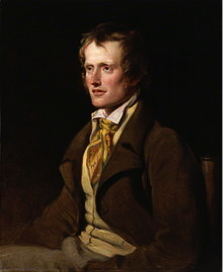 “The Northamptonshire Peasant Poet” was how John Clare is remembered. Born in 1793, the son of a farm labourer, he grew up in a small village called Helpston, close to the Cambridgeshire border. It was only six miles from Peterborough at a time when the old, agricultural ways were changing forever as the wheels of industry turned all over Europe. So many people were forced off the land to live in the towns as England underwent massive changes. Throughout all this John followed his father, working on the land and lamenting the loss of what was, of course, a hard way of life.
“The Northamptonshire Peasant Poet” was how John Clare is remembered. Born in 1793, the son of a farm labourer, he grew up in a small village called Helpston, close to the Cambridgeshire border. It was only six miles from Peterborough at a time when the old, agricultural ways were changing forever as the wheels of industry turned all over Europe. So many people were forced off the land to live in the towns as England underwent massive changes. Throughout all this John followed his father, working on the land and lamenting the loss of what was, of course, a hard way of life.
The gentle, lyrical poetry that John wrote at this time is very much a symbol of that lost age. It was a perfect depiction of a rural childhood, portraying the fears and instability of those times. It was common for children to both attend school and work on the farms at the same time and John took his lessons, when he could, in the church school of Glinton. He grew up suffering the effects of malnutrition and was never more than five feet in height. His employment varied from collecting pots in a public house to working as a gardener at the grand Burghley House. He tried life as a soldier and spent some time as a lime burner in his mid-twenties. As you can imagine, all of this contributed to his poor state of health in later life.
But poetry was his passion and two of his collections were published to great acclaim: Poems Descriptive of Rural Life and Scenery in 1820 and Village Minstrel and other Poems in 1821. These signalled a period of relative affluence. He was married and with annuities and subscriptions from a variety of sources his income was very healthy, but this did not last for very long. He soon found himself back working on the land and his failing health improved slightly but this also was short lived – illness was never far away.
It was not just his physical state that was so poor. He also suffered bouts of depression as he tried to reconcile his relatively glamourous life as part of the London literary set with his living situation back home, alongside very poor and often illiterate neighbours and friends. He described it thus:

He had a strong desire to write yet his growing family were a severe drain on his resources. By the time he published his last work in 1835, the Rural Muse, he had seven children. Financial and other pressures conspired to create a situation where he was close to a mental breakdown and he voluntarily went into a private asylum for some much needed care.
His writing continued here, yet it was actually the re-writing of some of Lord Byron’s work that occupied his time. He declared himself both Byron and Shakespeare reincarnated. After a number of years here he was allowed home but things steadily deteriorated once more until he was finally re-admitted, only this time to the Northampton General Lunatic Asylum. It was 1841 now and he was declared insane, the reason curiously given as being due to “years of poetical prosing”. Fortunately for Clare he received good treatment here and was encouraged to write, notably the famous poem I Am. You will see from the final verse of this poem below that he was thinking back to the days of his youth, free amongst the fields:

The rest of his days were spent in this institution and he died in 1864, aged 71. He is buried in Helpston churchyard, the village where he grew up and his poetry is commemorated every year by children of the John Clare Primary School who honour him every summer on the 13th of July- the date of his birth.

